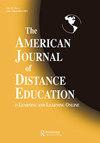现场培训还是虚拟培训?:比较社区培训的有效性
IF 1.3
Q2 EDUCATION & EDUCATIONAL RESEARCH
引用次数: 5
摘要
摘要:本研究的目的是探讨为收入和受教育程度有限的弱势群体提供以社区为基础的健康关系课程的参与者,通过课程交付平台获得知识的差异。使用从2019-2020年收集的613名参与者收集的数据,将接受现场培训的人(n = 440)与接受同步虚拟培训的人(n = 173)进行课程知识的比较。结果表明,与接受同步虚拟训练的参与者相比,面对面的参与者在后测试中获得的知识在统计上显著更高。这两组学生在知识获取方面的差异并没有被统计数据所解释。影响包括考虑虚拟交付中的适应性,这可能会缩小面对面和同步虚拟培训之间的差距,例如教学技术、演示风格、内容和材料以及参与者准备。本文章由计算机程序翻译,如有差异,请以英文原文为准。
In-Person or Virtual Training?: Comparing the Effectiveness of Community-Based Training
ABSTRACT The purpose of this study was to examine differences in knowledge gain by curriculum delivery platform for participants receiving a community-based healthy relationships curriculum for a vulnerable population with limited income and education. Using data gathered from 613 participants gathered in 2019–2020, those who received in-person training (n = 440) were compared to those who received synchronous virtual training (n = 173) on curriculum knowledge. Results indicate that in-person participants had statistically significantly higher gains in knowledge at posttest compared to the participants who received synchronous virtual training. The differences in knowledge gain were not accounted for by the demographics of the two groups. Implications include consideration of adaptations in virtual delivery that may close the gap between in-person and synchronous virtual training such as instruction techniques, presentation style, content and materials, and participant preparation.
求助全文
通过发布文献求助,成功后即可免费获取论文全文。
去求助
来源期刊

American Journal of Distance Education
EDUCATION & EDUCATIONAL RESEARCH-
CiteScore
7.20
自引率
3.10%
发文量
30
 求助内容:
求助内容: 应助结果提醒方式:
应助结果提醒方式:


